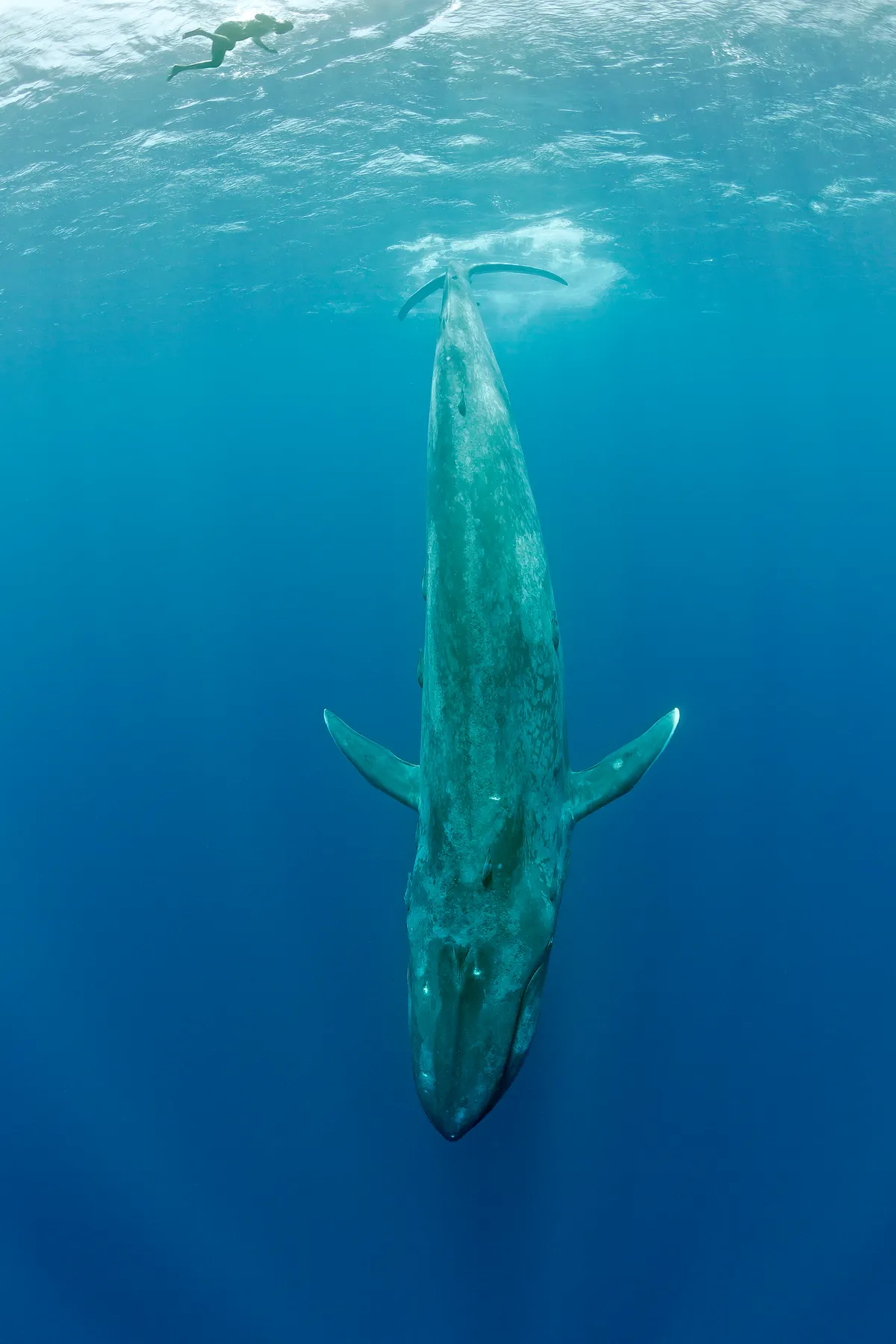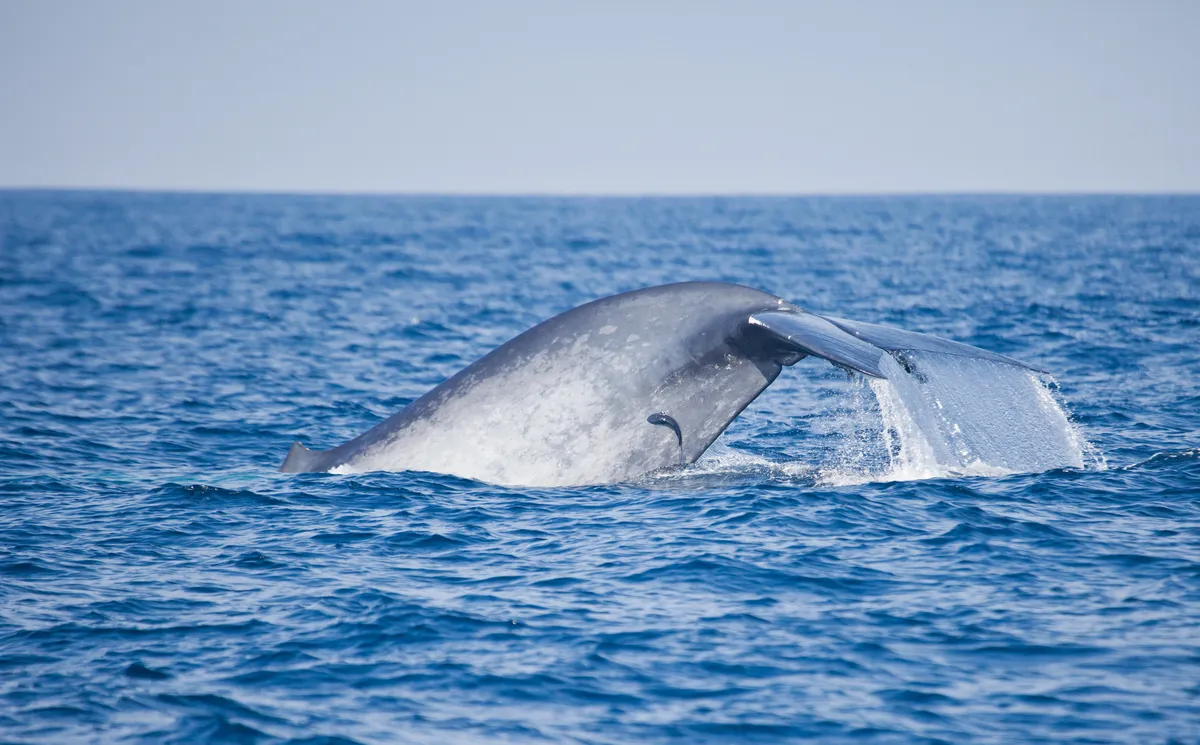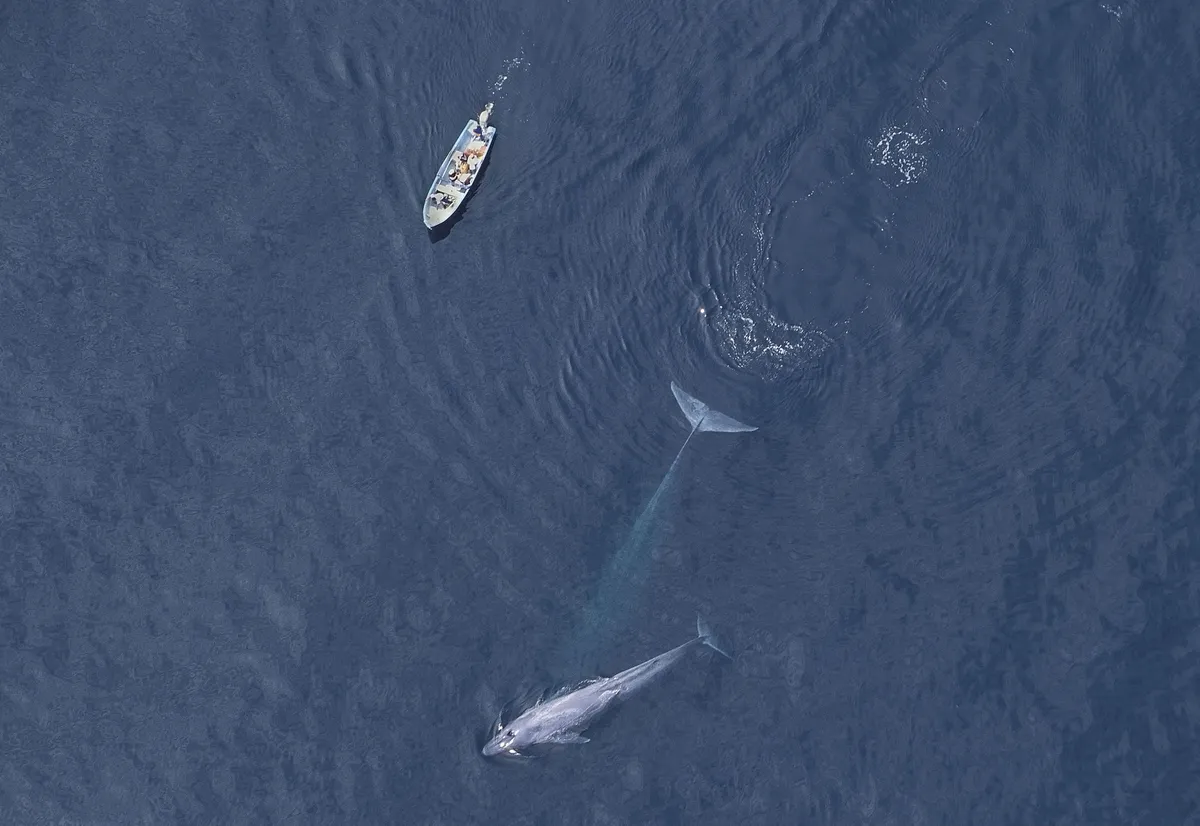Dive into the ocean with the majestic blue whale — the largest animal ever known to have lived on Earth.
Why is a blue whale so big?
In the sea, the whales cruise easily, but on land an animal the size of a blue whale would be crushed by is own weight without the support of large, very heavy bones. As its body is supported by sea water, it’s possible for such an enormous animal to exist without heavy bones.
Whales have to be big – as a mammal living in the ocean, which gets much colder than land, they have to be big enough not to lose too much body heat to the surrounding water. Blue whales are the biggest, and can grow to 33 metres, and weigh 180,000kg if female, or 150,000 if male.
In addition, the ocean’s free-flowing environment allows for a vast food supply, enough to sustain a blue whale, to be eaten with ease. However, whales are limited in their size by their metabolism, which gets faster as they get bigger, effectively putting a limit on growth.
Is a blue whale bigger than Megalodon?
Yes, the largest blue whale ever recorded was 108 feet long, while the largest Megalodon specimen was only 58.7 feet long. Both were alive in the ocean during the Miocene Epoch, but the huge shark became extinct about 2.6 million years ago. The shark ate a diet of prehistoric whales, which may have included juvenile blue whales – but at a certain point, they would have become too large to be vulnerable.
- Was Megalodon the world's most fearsome, largest apex predator ever? Meet the super-shark that could swallow killer whales whole but didn't like the cold
- Terrifying prehistoric sea monsters: 10 menacing ocean creatures that you'll be glad aren't alive today

Why is the blue whale called blue?
Blue whales are actually blue-grey, but they appear brilliantly turquoise in the water as they reflect the blue sky. They also have mottled markings on their sides that are unique to each whale, and which scientists can use to identify them.
Their undersides are light grey, or yellowy. In colder water, diatoms attach to the whales in vast numbers. These photosynthetic algae need a place to settle down, but in doing so, increase drag on the whale and colour it yellow with their bodies.

What do blue whales eat?
Blue whales feed almost exclusively on krill. During the summer months, they can consume as much as 40 million krill per day, and this is made possible by migrating to arctic regions, which have almost 24-hour a day sunlight during this time, leading to krill booms.Blue whales have overlapping plates of baleen hanging from their upper jaw instead of teeth. The whale takes in large volumes of water in its expansive throat, and as the water is expelled, the baleen fringes trap krill on the inside of the mouth.
- Minke whale guide: species facts, diet, where they live and how minke whales mate
- Why do bowhead whales have such large heads?
- Whales, dolphins and porpoises of the UK guide: which species to look out for, how to identify, and where to see them
- Humpback whales can learn songs from other populations, study reveals
- Whale shark guide: what they eat, where they're found and why they're endangered
How loud is a blue whale's song?
The song of a blue whale is painful for human ears, recorded at a cacophonous 188 decibels. Calls can be heard from up to 600 miles away, and sound travels faster underwater than in air. Because blue whales are solitary, it’s helpful for them to produce low-frequency, high intensity calls, that can be heard by whales many miles away.
Unlike humpbacks, both male and female blue whales sing, though females only sing in single notes while males sing in complex melodious tunes.
There is some evidence to suggest that populations of whales that are geographically separate produce distinct vocalisations. In a 2003 study, researchers described the most frequent sounds by North Atlantic blue whales, and compared them to blue whale sounds from other regions in order to draw conclusions.
When do blue whales sing?
In a 2018 study, researchers set out to characterise the calls of Northeast Pacific blue whales off the coast of southern California. The researchers found that males produced calls much more frequently than females did, calling 50% of the time, versus only 5% respectively.
In addition, most calls were produced at shallow depths of less than 30 metres, an interesting find considering that blue whales typically feed at depths of over 100 metres during the day, and only surface feed at night due to the vertical migrations of krill through the water column. The researchers’ findings supported the hypothesis that blue whales do not sing in cohesion with when they feed.
It has been demonstrated before that single note calls are associated with resting, while singing is associated with traveling behaviours in blue whales.
They also found that more calls were produced in the summer than in the winter. Furthermore, single-note calls were more frequent at dawn and dusk, while singing was most prevalent at dusk and night.
Do blue whales migrate?
Yes, blue whales undergo a migration and must change their eating habits depending on the time of year. They spend the summer months feeding voraciously in order to stock up for the migration.
For the other half of the year, the whales are busy mating and calving in tropical or temperate waters, which are superb nursery grounds with few predators for juvenile whales, but which are bare of krill. Calves drink their mother’s milk as they migrate back to the poles, and adult whales fast.
How does a blue whale reproduce?
During the summer months, whales pair off, with males following a female for weeks on end. If a few males are competing for the attentions of one female, the whales initiate a race, possibly for the female to determine which suitor is more physically fit. Sometimes males engage in tail slashes and head ramming during these events.
Like other whales, blue whales produce vocalisations and they may have a reproductive function. Sometimes males call to each other when in pursuit of a female. Males also have a song that is used to court females.
Blue whales reach sexual maturity between six and ten years old, or when males are about 74 feet long and females are about 79 feet long. Calves are not born every year, but rather at intervals of two or three years, and blue whales have a gestational period of twelve months. When a whale is newly born, it is already seven metres in length, about the size of an elephant.

Is the blue whale endangered?
Sadly, yes. Blue whales were targeted by commercial whalers when equipment became advanced enough to catch them, and a single 90 foot blue whale could yield up to 120 barrels of oil. In 1930, 29,000 were reportedly killed in one season.
Now, blue whales are a protected species, but they are slow to recover. It is estimated that 99% of the world’s population of blue whales was eradicated during whaling. Pre-whaling populations were about 350,000, but now there are only about 15,000 blue whales in the world’s oceans.
Researchers have found that blue whales feed during the day and rest near the surface at night. This makes them more vulnerable to ship strikes in darkness, and studies are being carried out to get more information on whale behaviour so that conservation efforts can be implemented most effectively.
How long have blue whales lived on earth?
Present day blue whales are even larger than their prehistoric ancestors, and they are thought to have diverged from other prehistoric whale species during the Miocene epoch, when mammals were first evolving, possibly as much as ten and a half million years ago.
How long do blue whales live?
The life expectancy of a blue whale is 80-90 years old, with the oldest blue whale recorded at 110 years – similar to a human.
How noise pollution affects whales
Whale communication lines are shrinking – research indicates that they can only hear each other for around 10 miles in today’s noisy oceans. A 2017 paper indicates that “these long-lived animals evolved to take advantage of acoustic conditions,” but that noise pollution had either “entirely (fin whales) to nearly entirely (blue whales) eliminated” the necessary acoustic conditions in essential foraging grounds for both species.
The researchers examined the Santa Barbara Channel and found that certain areas were 50-100 Hz louder than pre-industrial levels. This is specifically alarming for fin and blue whales, which communicate at extreme low frequencies.
Aside from limiting the ability for others to hear whale song, noise pollution could also damage eardrums or lungs of whales. Recent research has suggested that the use of military sonar may disorient or deafen cetaceans and play a role in strandings.
Research by Dr. Rosalind Rolland also indicates that whales become extremely stressed by noise pollution. Examining fecal samples is one of the only reliable ways to collect data on the metabolic processes of whales while alive, and during her study, Rolland measured levels of the glucocorticoid hormones present in the whale.
During the course of the study, two planes struck the world trade centre, killing 3,000 people. In New England, Rolland decided to continue her study. After the terrorist attack, commercial shipping was halted, and by chance the researchers found that levels of glucocorticoids experienced a massive unexplainable drop during the few days after the attack.
When reanalysing the data years later for a workshop on ocean noise, Rolland concluded that the whales were less stressed because they could hear each other clearly for the first time in many years.






